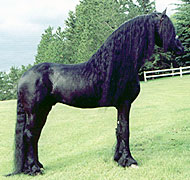 |
| Friesian Horse Deutsch: Friesenpferd (Photo credit: Wikipedia) |
Friesians
Brief History
This draft breed is rooted in Friesland, Northwestern Europe, which is now a part of the Netherlands. The original stock was descended from the order of Equus robustus (the big horse). In the 16th and 17th centuries, Andalusian lineage was introduced to the bloodline in the form of Spanish stallions which were abandoned on the battlefield during the war between the Spanish and the Dutch. This new blood endowed the Friesian line with higher knee action, smaller heads, and arching necks.
Description and Characteristics
The Friesian is one of the smaller draft horses, in stature and weight. In order for Friesians to be deemed purebred, and allowed to be used for breeding stock for a purebred line, they must be at least 14.3 hands (57.2 in., or 145.3 cm.) at the shoulder. And the subject must be solid black with no white markings on the legs or body. The typical height is 15.3 to 16.1 hands (155.4 to 163.6 cm., or 61.2 to 64.4 in.). The Friesian is heavily boned, and the adult averages about 1300 pounds (92.3 stones). This breed appears to be short and stocky. The thick manes and tails, and abundant fetlock hair are traditionally allowed to remain full and natural. The Friesian has a good temperament and is sensible but lively. The breed can be used for pulling, or for saddle riding. And while Friesians have the normal gaits - walk, trot, and canter - long tradition has emphasized the "big" trot which is typical of the breed.
 |
| Gypsy Cobs (Photo credit: Wikipedia) |
Gypsy Cob
History
This small draft horse traces its roots to the Romanys, who had no need for the larger drafts. For almost 100 years the Romany people, or Gypsies, have bred the cob to pull their traditional carts and "mobile homes" throughout the country lanes of Ireland and England. And although many of the "Travelers" - as the ones who move about the country are called - have changed to more modern conveyances, there are still those who cling to the traditional mode of travel.
Even though many people of the Romany heritage no longer travel, they continue to breed these colorful horses as a way of keeping tradition alive. As long ago the modern Gypsy's wealth is still, in a large part, measured by the size and quality of his horse herd.
Description and Conformation
The Gypsy Cob has no one specific color. The most common are pinto patterned, piebald, and skewbald. They are small, in that they traditionally stand 13 to 15.2 hands (52 to 60.8 in., or 132 to 154 cm.) at the shoulder. They are compact, yet sturdy and durable. Their stamina allows them to pull a loaded "living wagon", at a steady trot, all day long.
In order to be classified as a traditional Gypsy horse, they must have an abundance of hair and feathering. The feathering starts at the knee and grows all over the bottom half of the leg to the hoof.
The Gypsy Cob has been bred for a particular type for years, but can trace their ancestral roots back to Clydesdales, Shires, Friesians, and Irish Drafts as well a Connemara, Dales, and Fell ponies. This horse is typically known to be very sound and sane, a faithful companion, and to possess incredible versatility.
